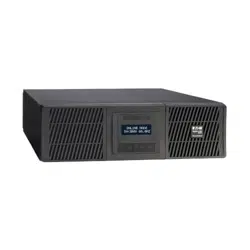Loading ...
Loading ...
Loading ...

Eaton Tripp Lite SmartOnline Series User Guide 614-40204—Rev 01 31
4. Remove the two screws to pull out the metal battery protection cover.
5. Pull out the handle of the battery pack, and slide the pack out slowly onto a flat and stable surface. Use
two hands to support the battery pack. See 7.4 Recycling The Used Equipment for proper disposal.
6. Verify that the replacement batteries have the same rating as those being replaced.
7. Put the new battery pack into the UPS. Seat the battery pack firmly into the UPS,
8. Verify that all of the alarms have cleared on the display.
9. Screw back the metal battery protection cover and the front panel, then clip the center cover back into
place.
10. If the UPS was shut down during the battery replacement process, see 5.1 Startup and Normal Operation
to power the UPS back on.
Replacing the EBM(s)
The EBM is heavy. Lifting the cabinet into a rack requires a minimum of two people.
To replace the EBM(s):
1. Unplug the UPS's EBM power and battery detection cables. If additional EBM(s) are installed, unplug the
EBM power cable and battery detection cable from each EBM.
2. Replace the EBM(s). See 7.4 Recycling The Used Equipment for proper disposal.
A small amount of arcing may occur when connecting an EBM to the UPS which is normal and will not
harm personnel. Insert the EBM cable into the UPS battery connector quickly and firmly.
3. Plug the EBM cable(s) into the battery connector(s). Up to four EBMs may be connected to the UPS.
4. Verify that the EBM connections are tight and that each cable has adequate bend radius and strain relief.
5. Connect the battery detection cable(s) to the UPS connector and the EBM(s).
6. If the UPS was shut down during the battery replacement process follow the start procedure in the Start-
up and Normal Operation section.
77..44 RReeccyycclliinngg TThhee UUsseedd EEqquuiippmmeenntt
Contact your local recycling or hazardous waste center for information on proper disposal of the used
equipment.
RISK OF ELECTRIC SHOCK - Observe the warning associated with the risk of electric shock symbol.
This symbol indicates that you should not discard the UPS or the UPS batteries in the trash. This
product contains sealed, lead-acid batteries and must be disposed of properly. For more information,
contact your local recycling/reuse or hazardous waste center.
Special Symbols
The following are examples of symbols used on the UPS or accessories to alert you to important
information:
RISK OF ELECTRIC SHOCK - Observe the warning associated with the risk of
electric shock symbol.
CAUTION: REFER TO OPERATOR'S MANUAL - Refer to your operator's manual for
additional information, such as important operating and maintenance
instructions.
This symbol indicates that you should not discard the UPS or the UPS batteries
in the trash. This product contains sealed, lead‐acid batteries and must be
disposed of properly. For more information, contact your local recycling/reuse or
hazardous waste center.
This symbol indicates that you should not discard waste electrical or electronic
equipment (WEEE) in the trash. For proper disposal, contact your local
recycling/reuse or hazardous waste center.
Eaton, Powerware, and BladeUPS are registered trademarks of Eaton Corporation or its subsidiaries and affiliates.
Phillips and Pozidriv are registered trademarks of Phillips Screw Company.
ECopyright 2008–2010 Eaton Corporation, Raleigh, NC, USA. All rights reserved. No part of this document may be
reproduced in any way without the express written approval of Eaton Corporation.
This symbol indicates that you should not discard waste electrical or electronic equipment (WEEE) in
the trash. For proper disposal, contact your local recycling/reuse or hazardous waste center.
Recycling The Used Equipment
Loading ...
Loading ...
Loading ...
